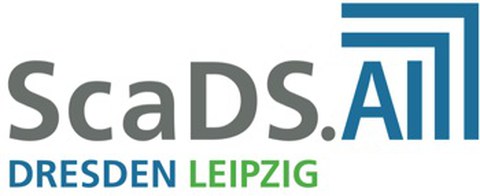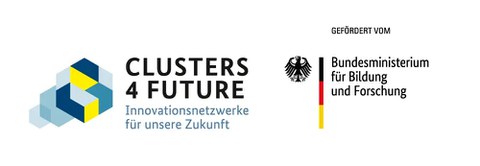Research projects
Current research projects
Table of contents
Further information:
CeTI
Cluster of Excellence "Centre for Tactile Internet with Human-in-the-Loop" (CeTI)
Next level of digitalization: humans and machines interact in real time
The "Centre for Tactile Internet with Human-in-the-Loop Interaction" at TU Dresden aims to take collaboration between humans and machines to a new level. In future, people should be able to interact in real time with networked automated systems in the real or virtual world.
Further information can be found here
EBRAINS 2.0
A Research Infrastructure to Advance Neuroscience and Brain Health , GA 101147319
Sub-project: Base infrastructure (WP6)
Duration: 01.01.2024 to 31.12.2026
Funding: EU
WP 6 coordinates, plans and integrates the access to base infrastructures, including cloud resources, storage, High-Performance Computing (HPC) and Neuromorphic Computing (NMC) resources from internal and external providers (e.g., EuroHPC JU and FENIX, NN resources, commercial cloud providers, neuromorphic compute centers) to enable a sustainable EBRAINS beyond the end of the project. The operation and maintenance of the base infrastructure resources is one of the main responsibilities of WP6, which must be implemented in a form that ensures sustainability. We will develop in a co-design fashion a sustainable base infrastructure roadmap together with internal and external stakeholders. The goal is to further formalise interfaces, improve support for, and align requirements with HPC and especially Petascale and Exascale system providers, federated infrastructure services, data processing facilities and other resource providers. Building on best practices from the HBP and ICEI, allocation and management of resources for internal and external EBRAINS users is provided. We also aim to support standard processing workflows (possibly multi-site), by supporting the use of container and standard virtual machines. Partnering with WP5 and WP7, a multi-tiered support system will be established, also including a scientific service team, which supports users in performing novel scientific endeavors. We will also facilitate the processing of sensitive data in the cloud to the best of our ability and initiate initial steps to enable the processing of such data on high-performance computing resources
Neuromorphic Computing on ebrains.eu
ESCADE
Subproject: Neuromorphic Hardware for Sustainable AI Data Centers
Duration: 01.05.2023 until 30.04.2026
Funding: BMWK
(BMWK funding program "Digital Technologies for the Economy" innovation competition "Green Tech")
ESCADE:
Energy-Efficient Large-Scale Artificial Intelligence for Sustainable Data Centers. ESCADE pursues the development of sustainable end-to-end solutions that ensure the operation of energy-efficient data centers with innovative chip technologies by designing use cases (Sustainable AI Use Cases) and developing AI applications based on cognitive AI technologies.
EVENTS
Sub-project: Energy-saving distributed sensor systems for machine vision
Duration: 01.11.2022 until 31.10.2025
Funding: BMBF
The EVENTS project is developing a mobile installable, distributed hardware platform for time-critical video analysis and reaction that will take the interaction between living beings and autonomously acting robots to the next level. High energy efficiency is achieved through distributed data processing and event-based algorithms, as well as hardware development geared towards this. EVENTS is developing its own edge chip and is using the neuromorphic Loihi2 chip from Intel together with an edge cloud based on the SpiNNaker2 architecture. The system's offline capability increases data protection and availability. Standardized software interfaces enable simple application development and market development of the new hardware platform. It is being tested in two use cases: mobile robots for automated logistics in an agricultural business and automated tracking and behavioral assessment of animals in a cattle barn in real time.
TU Dresden is coordinating the project and is the main developer of the edge node for pre-processing camera data. To this end, it plays a leading role in the implementation of the edge chip developed in the project and contributes to the integration with the Loihi2 chip. TU Dresden also plays an important role in the hardware/software code design of the distributed processing algorithms. It is also responsible for setting up and providing the SpiNNaker2-based edge cloud and is involved in integrating the newly developed and assembled hardware into an overall system for implementing the two use cases. Finally, TU Dresden is taking on tasks in the evaluation of the newly developed hardware in terms of capabilities and energy efficiency and, based on this, is participating in the evaluation of the sustainability of the overall system.
PRIMI
Performance in Robots Interaction via Mental Imagery (101120727)
Duration: 01.11.2023 to 31.12.2027
Funding: EU (Horizon Europe)
The next generation of personal robotic systems needs to reach a level of cognition and motor intelligence that provides autonomy in any environment, effective interaction with humans, and adaptation of their actions to a broad range of open, dynamic situations. Robots are expected to be able to predict perceptual and functional changes that result from human actions and replicate human activities taking into consideration their own capabilities and limitations.
The required human-like physical performance and reasoning cannot be achieved with the mainstream AI and robotics paradigms, because they are missing the required co-design of body (robot) and mind (AI) and are based on inefficient computing and sensing resources that cannot be scaled up to the required level. To go beyond what is currently possible, PRIMI will synergistically combine research and development in neurophysiology, psychology, machine intelligence, cognitive mechatronics, neuromorphic engineering, and humanoid robotics to build developmental models of higher-cognition abilities - mental imagery, abstract reasoning, and theory of mind - boosted by energy-efficient event-driven computing and sensing. It will produce a new unifying concept for the next generation of autonomous interaction technologies, capable of more autonomous, faster, safer, and precise interaction with real-time learning and adaptation, thanks to the integration of the capabilities to mentally represent themselves, the physical and social worlds, resemble experiences and simulate actions. PRIMI's ambition is to induce a paradigm shift in AI and robotics to create truly autonomous socially interactive robots, which will offer new technological perspectives for transforming personal robotic services.
As a proof-of-principle of the technological advancement in a relevant scenario, prototypes of neuromorphic humanoid robots will be validated in clinical pilot studies of robot-led physical rehabilitation of stroke survivors.
Project website, LinkedIn, X (Twitter), YouTube
PRISTINE (ZEN2)
Subproject: Pattern recognition for in vitro signal analysis using fully integrated neuroelectronics
Duration: 01.08.2019 until 31.07.2024
Funding: BMBF
The project presented here follows on from the pilot innovation competition "Energy-efficient AI system" and, from TUD's perspective, serves in particular to increase the market maturity of the approach developed there for the event-based classification of time series using neural networks (ZEN). The focus of the follow-up project presented here is to expand the concepts of hardware-based pattern recognition developed in ZEN (time series classification with event-based neural networks) and to add analog measurement data acquisition, which is directly integrated together with the ZEN module on a single IC. In addition to the adaptation to neuronal signal data, the development of a data management system for real-time application of the ZEN module is also an important part of the project, which makes it possible to classify neuronal firing dynamics directly as they arise and thus generate a feedback signal that can be used, for example, to regulate the dosage of an active ingredient or to generate an alarm when pathological behavior is detected. At the same time, the close collaboration with TUM-NEL and TUM-NBE offers the possibility to solve limitations of the currently pursued approaches in highly parallel measurement data acquisition. Typically, the IC area is defined by the area of the integrated circuits and the number of contact pads required, but the influence of the contact pads dominates in the case of highly parallel data acquisition systems. By using fully integrated electrodes on the chip surface, this problem can be avoided and a more area-efficient overall system can be created. This development step is to be evaluated within the project in order to open up perspectives in the field of innovative active implants.
ScaDS.AI
Center for Scalable Data Analytics and Artificial Intelligence
ScaDS.AI (Center for Scalable Data Analytics and Artificial Intelligence) Dresden/Leipzig is a center for Data Science, Artificial Intelligence and Big Data with locations in Dresden and Leipzig. It is one of the five new AI centers in Germany funded under the federal government's AI strategy by the Federal Ministry of Education and Research and the Free State of Saxony. It is established as a permanent research facility at both locations with strong connections to the local universities: the TUD Dresden University of Technology and the Leipzig University.
Scale4Edge
Scalable infrastructure for edge computing
Subproject: AI/DSP accelerator IP for RISC-V
Duration: 01.05.2020 until 31.12.2025
Funding: BMBF: 16ME0136
The development goal of the overall project "Scale4Edge" is a commercial ecosystem for a scalable and flexibly expandable edge computing platform. This system is to be based on the free RISC-V instruction set architecture. The ecosystem covers all essential aspects such as low-power, security, reliability, verification, testing, compilers, software libraries and debugging. It is supplemented by specification, verification plan and documentation. It therefore offers a scalable, tailor-made complete solution including support. This also includes standard-compliant design processes, partially open-source software and also the safety and security of the platform as well as an intensive review and analysis of the developments.
Within the RISC-V ecosystem, the work in the TU Dresden sub-project focuses on the design and implementation of hardware accelerator IP for artificial intelligence (AI) applications.
SECAI
School of Embedded Composite Artificial Intelligence
The School of Embedded Composite Artificial Intelligence (SECAI) is a project of TU Dresden and Leipzig University to promote artificial intelligence (AI) in research and education. SECAI awards scholarships, strengthens teaching, finances researchers and promotes international exchange.
Further information can be found here
SEMECO-A2
Sub-project A2: Psychoactive multisensory communication implant
Duration: 01.05.2023 to 30.04.2026
Funding: BMBF
With the Else Kröner Fresenius Center for Digital Health, the 5G++Lab Germany and the Barkhausen Institute, the future cluster SEMECO around the TUD Dresden University of Technology offers ideal conditions for innovative and sustainable cooperation at Europe's leading academic and industrial location for microelectronics, communication technology and explainable AI - i.e. Institute of Artificial Intelligence whose results can be understood and interpreted by humans. As part of the future cluster initiative (Clusters4Future), an ecosystem is being created that taps into the innovation and future potential of the semiconductor and microsystems technology industry for medical technology, reconciles the justified regulatory and safety requirements and develops applications for the market.
Further information can be found here









